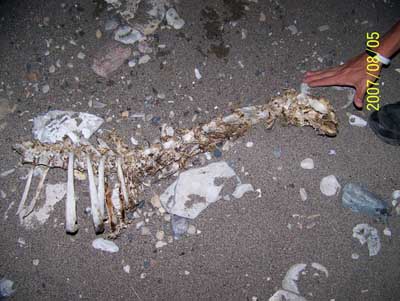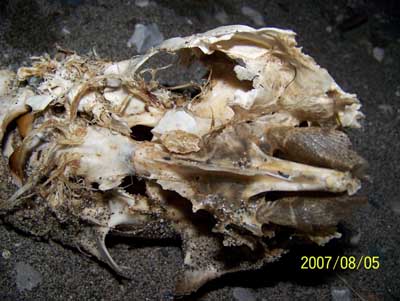Article Index
The following is a PSICAN two-page investigation report of an unknown animal skeleton found at Providence Bay, Manitoulin Island, ON, Canada – Investigation conducted by Dana-G Currie, PSICAN Cryptozoologist - Includes Photographs.
Mr Ray St. Louis Jr., of North Bay, ON contacted PSICAN's Senior Cryptozoologist to report that he had located a strange carcass of an unidentifiable animal on a beach on Manitoulin Island, ON. PSICAN then assigned this investigation to the author of this article (Dana Currie) and the lead investigator for lake monster sightings for PSICAN.
As the story goes, Mr Ray St. Louis Jr. was camping at a Tent & Trailer park in Providence Bay, Manitoulin Island in the Summer of 2007. On a clear and beautiful night, he and his family decided to go for a walk to look at the beautiful sunset accentuated by the majestic waters of Lake Huron.
Mr Ray St. Louis Jr and his Fiancée walked along the shoreline for a little while, until his Fiancée’s knee was too sore, so, Mr Ray St. Louis Jr and his step-son walked on for a bit and then started their return. As they were walking they spoke with a couple they met along the way, who were from the Ottawa area.
The man brought to Mr Ray St. Louis Jr’s attention a strange skeleton. Mr Ray St. Louis Jr’s stepson, who is learning to become a paediatrician at the University of Ottawa, thought it looked a bit strange as did the couple, who must have had some formal discipline in biology or veterinary medicine had made some very good remarks about the structure of this creature.
At first glance, the couple from Ottawa believed that the remains were that of a small deer who may have drowned and was washed up onto the shore.
However, the man showed Mr Ray St. Louis Jr that this could not be a deer due to the dorsal bones, which he indicated were primarily found only on aquatic animals.
Also, the ribs were shaped very wide, long, and were close together indicating a narrow girth, not small, but narrow like the design of a fish. The animal also had a very long neck, which is why Mr Ray St. Louis Jr came to the conclusion of a deer.
However, this man pointed out to Mr Ray St. Louis Jr that a deer had legs and therefore, there should be bone structures indicative of this, which were not present and was impossible for this to be a deer. This animal was too large to be a dog due to the sheer length of the neck, the rib formation (for lack of a better term), and the orbital sockets were very large and not proportional to a canine, deer, or any other type of fish or aquatic animal found in these parts.
There was evidence that this creature had no legs at all (front or hind). This person also indicated something about the number of spinal vertebrae. Mr Ray St. Louis Jr. wished that he could remember this part, but by this point he was so amazed that he forgot exactly what the gentleman had remarked. Mr Ray St. Louis Jr. felt that the photos were clear enough for a Doctor of Veterinarian Medicine to assess this. The man had said something about the number of discs not being normal for known (documented) creatures.
As Mr Ray St. Louis Jr continued examining this creature, he started to realize that this was indeed a creature not native to these parts and, to this day, he is perplexed by what this was. He is not saying that it is a baby Nessie but he said he was sure of what it was not. It was not a muskrat, a beaver, a deer, any type of fish, a dog, and not a bird; so, he sought help in identifying the creature.
Mr Ray St.Louis, Jr felt that the carcass was only a few days old at most because there were some parts missing and there appeared to be some flesh still being eaten by insects. Primarily, its back end was totally gone, which was most unfortunate, because this would have spoken volumes. Mr Ray St.Louis, Jr. would have taken the skeleton with him but he did not have anything to put it in and he was not really anxious to put it in the trunk of his car along with their gear.
Mr Ray St.Louis, Jr provided many images of the skeleton found on the beach but to large amount of computer storage space required, the author/investigator has only provided what are felt to be the best of these images. Image 1 below is of the body of the unknown creature and image 2 on page 2 is the head area of the unknown creature.


The author and investigator then contacted a Marine Biologist at an Ontario university and asked her what her professional option was on the images. She replied the following,
“After looking at the image, I would take a fair guess for it to be a livestock animal or possibly a deer. The pictures don't give the greatest resolution for me to make a proper guess and the photos of the skull have not been taken at various angles. The picture you sent shows the underside of the skull with the back of the head the furthest away from the spine (Meaning that it has been turned around backwards and is upside down), which is probably why you were questioning its appearance. To make a good guess at the origin of the skull, I would need to see the front end (where the teeth would be) and the top view of the skull”. If you wanted to do further research, I would consider looking into it being a deer, alpaca, young moose, young llama, etc... It doesn't appear to be a predator because the orbitals are located on the side of the head.” The Marine Biologist’s name will not be made public based on a request from her, but it can be provided to PSICAN staff, if requested.
At about the same time, Mr Matt Butler a professional photographer with Extreme Imaging in Barrie, ON examined the images. He felt the images were authentic and felt the thing in the images had a long looking neck but he could not conclusively say what type of creature it might be.
Next, I contacted a resident of Manitoulin Island, Mr Glenn Black who resides near the site where images of skeleton were taken and asked him to search the beach to see, if he could locate anything.
My description to Mr Black was as follows, “You are searching for a skeleton of approximately 3 to 5 feet in length. Also, the ribs are shaped very wide, long, and are close together indicating a narrow girth, not small, but narrow like the design of a fish. The animal also has a very long neck.
This animal was too large to be a dog due to the sheer length of the neck, the rib formation, and the orbital sockets in the skull are very large and not proportional to a canine, deer, or any other type of fish or aquatic animal found in that region. There was evidence that the creature had no legs at all (front or hind). It's back end was totally missing.
Mr Black searched the beach area and reported back the following to the author/investigator, “I went to the ProvBay docks with my wife. We did a grid search pattern over the entire sand and stoney beach area, approx 250 yards along East side of beach from Prov Bay dock, up to start of sheet rock and 25 yards beyond. We found numerous crab legs, shells, bone from a chicken wing (Col. Saunders ?), and 2 fish vertabrae and rib bones, but nothing like what you have pictured. We also searched the West side in case directions were garbled, for another 200 yards. I scanned the water to the gravel trough (approx 3 ft out in the water, in case a storm had washed it out. Nothing. Sorry. Your pictures appear to me to be a dead faun (baby deer), caught while drinking, by a wolf ???.”
In conclusion, after many hours of investigation and with the assistance of several other people, a Marine Biologist, a professional photographer and a Manitoulin Island the author/investigator feels that without having the skeleton of the creature, it is difficult to determine whether it was a yet to be discovered aquatic life form or a baby deer, a alpaca, a young moose or possibly a young llama. This concludes this investigation unless the skeleton of this animal is located.


